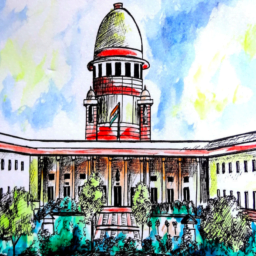INTRODUCTION
After Bombay High Court Justice Pushpa Ganediwala’s controversial judgments in child sexual abuse cases, the Protection of Children from Sexual Offenses (POCSO),2012[1] Act has been in the headlines recently. The decision of a court to acquit a man accused of assault under the Protection of Children from Sexual Offenses Act (POCSO) purely on the basis that he groped the youngster over her clothes without making skin-to-skin contact. The HC had concluded that simply touching or pressing a child’s clothed body did not constitute sexual assault. This has created shock waves among child rights and women’s rights activists in Maharashtra as well as nationally. The decision appears to be a futile hair-splitting exercise that limits the scope of the Act. The POCSO Act drew attention in 2019 when it was amended to increase the minimum sentence for serious and penetrative sexual assault on children under the age of 16 from 10 to 20 years, with the possibility of life imprisonment or death.
The POCSO Act’s Importance
The POCSO Act, which was passed in 2012, is gender-neutral, recognizing that boys can also be victims of sexual abuse. It considers everybody under the age of 18 to be a child. The Indian Penal Code does not recognize that boys can be sexually assaulted.
The Act further broadened the definition of what constitutes a sexual offence against a kid. It included non-penetrative sexual assault as well as aggravated penetrative sexual assault in the definition of sexual assault (sections 3 to 10). In contrast to the IPC, this child protection statute places the burden of proof on the accused, following the principle of “guilty until proven innocent.” The POCSO Act also established measures to make the criminal justice system more child-friendly and to prevent re-traumatization. Everything from how the child’s statement should be documented to the medical examination to the designation of special child-friendly courts is covered.
The special courts established under the POCSO Act must be child-friendly as well. allowing the youngster to take regular breaks during the trial; ensuring that the youngster is shielded from the accused during evidence gathering and cross-examination. Depending on the Special Court’s discretion, in-camera proceedings are also allowed. When a sexual offence against a child is committed, the police may add sections of the POCSO Act to the First Information Report (FIR). While special laws override the IPC, the FIR frequently mentions portions of both. An FIR, for example, would charge someone with rape under section 376 of the IPC[2] as well as applicable sections of the POCSO Act. The penalties under POCSO are more severe than those under the IPC.
Statutory Interpretation
Section 7 of the Act states that “Whoever, with sexual intent, touches the vagina, penis, anus or breast of the child or makes the child touch the vagina, penis, anus or breast of such person or any other person, or does any other act with sexual intent which involves physical contact without penetration, is said to commit sexual assault.” While Section 8 carries a punishment of 3-5 years, a person convicted under Section 354 of the IPC faces punishment of 1-5 years. The special court ruled that the accused had been proven guilty of both Section 354 and Section 8 of the POCSO Act. It considered Section 42 of the POCSO Act, which provides that in such instances, the offender is subject to whatever legislation imposes a “higher in degree” penalty.
“Even if the charges punishable under Section 354 of the IPC[3] and Section 8 of the POCSO Act are proven, the accused must be punished under the provisions of the POCSO Act, as this is the particular provision dealing with offences against minors, as mandated by Section 42 of the POCSO Act.”[4] As a result, the accused would be punished under Section 8 of the POCSO Act rather than Section 354 of the IPC, according to the court, which sentenced the defendant to three years in prison.
The judge in the HC decision, which subsequently was stayed by the Supreme Court, concluded that because the accused had similarly taken the victim inside his residence and caressed her breasts, there was no skin-to-skin contact, it constituted to punishment under Section 354 of the IPC. SC stayed the judgment with Attorney General KK Venugopal submitting the document mentioning “Bombay High Court’s skin to skin judgement will have devastating results and sets a dangerous precedent” while adding to that he said: “This would mean someone can wear a surgical glove and exploit a child and get away scot-free. The accused tried to bring down the salwar and even then, bail was granted. This would be a precedent for magistrates in Maharashtra. Better appreciation would be needed for the definition of sexual assault.”
The Nagpur bench of the Bombay High Court has been roundly chastised for its lack of sensitivity towards child sexual assault victims, the judgement is reasonless, and the interpretation it has given to the definition of sexual assault under POCSO defies basic rules of interpretation, replacing the legal view with the court’s personal view.
Way Forward
Courts are advised to treat sexual assault against children strictly and to apply an interpretation that is consistent with the law’s goal of protecting children from sexual abuse and exploitation. Furthermore, converting a POCSO conviction to a case of molestation under section 354 of the Indian Penal Code is an incorrect interpretation. It defeats the purpose of passing the POCSO legislation. The Bombay High Court’s Nagpur Bench failed to recognize that the POCSO Act is a special law enacted to deal with cases of sexual assault against minors. This narrow interpretation may allow a person to exploit a child without disrobing her and escape punishment, even avoiding prosecution under the POCSO law. Any requirement that “additional layers” be violated before a crime can be declared committed would kill the POCSO Act’s soul. Such requirements are a step backwards for the justice of child sexual assault victims. As mentioned by the Justice Verma committee[5], “there is an urgent need to audit the performance of all institutions of governance and law and order”. A sensible approach should be the need of the hour.
Author(s) Name: Apeksha Mishra (National University of Study and Research in Law, Ranchi)
References:
[1] THE PROTECTION OF CHILDREN FROM SEXUAL OFFENCES ACT [2012] <https://indiacode.nic.in>
[2] SECTION 376 OF THE INDIAN PENAL CODE [1860] – DEFINITION OF “RAPE”
[3] SECTION 354 OF THE INDIAN PENAL CODE [1860] <https://indiakanoon.org>
[4] SECTION 42 OF THE PROTECTION OF CHILDREN FROM SEXUAL OFFENCES [2012]
[5] JUSTICE VERMA COMMITTEE [2013] <https://prsindia.org>
















